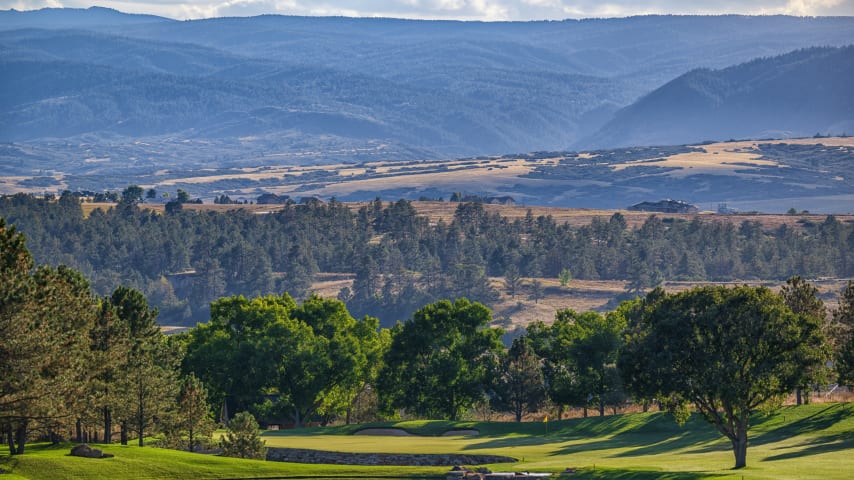Altitude adjustment: Colorado elevation introduces intriguing challenge at BMW Championship
7 Min Read

Altitude's impact on golf shots
Written by Paul Hodowanic
CASTLE PINES VILLAGE, Colo. — Akshay Bhatia surprised himself.
He knew his breakthrough moment was close last summer, but he didn’t expect it to come when it did.
“Barracuda was a tournament that I thought I would never win,” Bhatia said.
The reason is much more granular than course fit, form or any ounce of the imposter syndrome common for a burgeoning young athlete. It had everything to do with the setting. Old Greenwood, the annual venue for the Barracuda Championship, is situated nearly 6,000 feet above sea level in Truckee, California.
“I hit so many different flights and curve it a lot, so it's such a big adjustment,” said Bhatia, who won his second PGA TOUR title at this year’s Valero Texas Open.
The thinner air found at high altitudes doesn’t just make balls fly farther. It also makes them curve less. The impact of altitude is more nuanced than simply subtracting 10% from a shot’s distance, and it’s an adjustment that players will need to make rather quickly at this week’s BMW Championship at Castle Rock Golf Club in Castle Pines, Colorado.
The added variable of altitude is one that PGA TOUR players rarely face, if ever. The Barracuda Championship, which is annually played the same week as The Open Championship, is the lone stop that challenges players’ ability to adapt to the thinning air.
The World Golf Championships-Mexico Championship was played more than 7,500 feet above sea level at Mexico City’s Club de Golf Chapultepec from 2017 to 2020. The BMW also was played in Colorado a decade ago when Billy Horschel won at Cherry Hills Country Club in the Denver suburbs. For some, the BMW Championship could be their first time competing at altitude as a pro, or in their entire golf career.

Billy Horschel poses after his two-stroke victory at the BMW Championship at Cherry Hills Country Club in 2014. (Jamie Squire/Getty Images)
“There is still that doubt in your mind, especially if you've got to carry water and there's wind blowing into you and you know the ball's going further, trying to figure out those numbers. (Altitude) does play with your mind a little bit,” said Horschel, who also spent several summers in Aspen. “You've just got to commit to the shot you want to hit and trust numbers that you've been seeing all week as we've been prepping for the tournament.”
Unlike other elements, like rain and wind, altitude can’t be seen or felt (except for the burning in their lungs as they gasp for breath in the thinner air). But altitude’s effect will be ever-present at Castle Pines, a mountainous layout that sits more than 6,200 feet above sea level. The science that explains why a golf ball travels farther in warmer temperatures is the same for altitude. When the temperature increases, the air density lowers. Thinner air exerts less drag on the ball, allowing it to fly more easily through the air. With less force acting on the ball, it maintains its speed longer and travels further.

Altitude's impact on golf shots
The same is true at elevation. As altitude increases, air density decreases. That’s why Castle Pines will measure a record 8,130 yards this week. At sea level, that’s roughly 7,350 yards long, about the standard on TOUR. The 659-yard, par-5 opening hole would play just under 600 yards at sea level.
While the general premise that golf balls fly farther at elevation is true, how much further is up for debate, as are altitude’s lesser-known effects. It’s often said that elevation adds 10% of distance (a stock 100-yard shot will travel 110 yards at elevation, for example), but that refrain is a bit rudimentary. The actual percentage will depend on the club being used, as well as an individual player’s launch characteristics – spin rate, launch angle, average apex and descent angle. The time of the day and temperature plays a role, too. It makes a caddie’s job difficult this week, as all those factors must be considered when providing yardages for their player.
“The actual rule of thumb is there is no rule of thumb,” said Trackman tour manager Harrison Shih.
Trackman’s data shows the clubs most affected are the mid- and short-irons (6- to 9-irons), while the top end of the bag (drivers/woods) is less affected. That’s a result of the ball traveling lower in the air at altitude. Because the air is less dense and imparts less force on the ball, the lift force is also lower. With longer, lower-lofted clubs, that means the distance gains are mitigated because of the ball doesn’t stay in the air as long as at sea level.
However, longer shots will also have a lower angle of descent because of the decreased lift. That means shots won’t land as softly and will roll more after impact. That will make shots harder to stop if fairways and greens are firm.
“When you go to high altitude, you're going to hit the ball lower in the air. That's kind of a weird thing,” said Marty Jertson, Ping’s vice president of fitting and performance, in a 2023 episode of the "Ping Proving Grounds" podcast. “Like your brain might be struggling with that. Like, oh, if I'm hitting it further, I heard I should launch it high or something when (I) go to high altitude. But naturally speaking, this is why (airport) runways are longer in Denver, and they're very short in San Diego.”
Add in each player’s unique game, and it becomes a complex equation to accurately assess each shot. For high ball hitters, some clubs may fly upwards of 15% further, and they may average over 10% across all clubs. Pros with a low ball flight may have no clubs that average over 10%.
Some players also may adjust their trajectory, opting to hit it higher in Colorado to counteract the decreased lift on the ball. That means their shots will fly even farther because they’ll get the benefits of the decreased drag while mitigating the lesser amount of lift. That will allow them to maximize the distance gains from altitude, according to a video on Trackman’s website. Players also may tee their drives higher and switch to hybrids in an attempt to get higher launch angles.
Altitude doesn’t just mean that drives will fly farther. They’ll also fly straighter because the decreased air density exerts less force on the ball, according to Titleist. That means less curvature, which means fairways will play wider, but players also will have a harder time intentionally hitting hooks and fades.
It’s an adjustment that players must make in just a few days. The 50 players who qualified for the BMW Championship commuted from Memphis, Tennessee, on either Sunday or Monday, depending on when they finished the FedEx St. Jude Championship. In addition to higher altitude, players also will face less humidity in Colorado than in Tennessee.
The introduction of Trackman and other launch monitors has made the transition easier, but it’s still a stressful undertaking for players. Throw in the dramatic elevation changes at Castle Pines, and players will have plenty to ponder on each approach shot. They’ll also face some club selections that will be hard to believe. While Trackman and other launch monitors can simulate the effect of altitude before a player arrives in Colorado, some players will have to see the increased yardage to believe it.

A view of the third hole at Castle Pines Golf Club. (Credit Castle Pines)
“I think it's going to help to sort of have your brain see it, your eyes see it and have your brain realize, okay, that ball actually flew 225 yards downwind and it was an 8-iron or something like that,” Xander Schauffele, the winner of two majors this year, said last week in Memphis. “I heard there's a few 90-foot drops over water, par 3s that are 220 yards, and you're sitting there like is that an 8-iron or 5-iron? It's going to be interesting for everyone.”
Will Zalatoris, who won a Korn Ferry Tour event in Colorado four years ago, has seen how different shots are impacted by the altitude.
“There's times when I've played in Denver where I'd have 170 yards and I'd hit gap wedge and I'd just throw it up in the air and it feels like it's never going to come down,” said Zalatoris. “But then I could also hit a 9-iron from 104 yards and hit it low and it'll go kind of a similar distance to back home.”
Shih, the Tour Trackman rep, said a few caddies reached out to him during the FedEx St. Jude Championship to inquire about how their player may be affected this week. Largely, though, players won’t begin prep until they arrive on-site at Castle Pines. There will be an inherent advantage for some who are familiar with it. Wyndham Clark grew up in Colorado and has grown accustomed to it.
“The biggest thing is going to be trajectory,” Clark said. “I really think whoever can control the ball the best probably wins that event.”
That’s true at any altitude.








